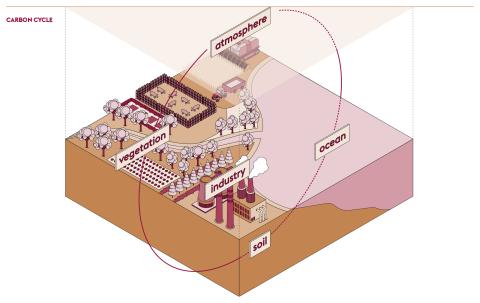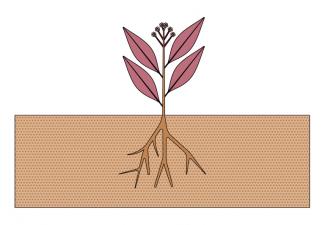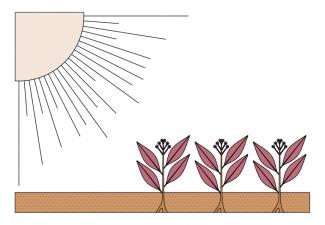
Reconciling carbon, plant, soil, and climate
(This article was originally published in L'Édition N.19)
As the fourth most abundant element on Earth, carbon is everywhere. Yet it plays different roles according to the environments in which it is found. In the form of gas in the atmosphere, carbon contributes to global warming. But when it is absorbed by soils, especially through plants, it becomes essential to the health and fertility of agricultural land. Couldn’t this present a multifaceted opportunity to better store carbon in soils?
About one third of the Earth’s surface is land. In June 2020, members of the Intergovernmental Panel on Climate Change (IPCC) released a special report on Climate Change and Land in which world scientists stated that one quarter of the land on Earth is considered degraded, and three quarters is under anthropogenic exploitation or occupation. The planet’s soils are being depleted, ignored, and mistreated and yet they are home to a large proportion of the Earth’s biodiversity. In 2010, scientists appointed by a European commission established that the land surface was at that time home to about one quarter of the planet’s total biodiversity.
To maintain this terrestrial biodiversity, it is imperative to devote attention to soil health. Healthy soils are defined as those that do not pollute their environment due to toxic elements in their composition and that have fertile properties arising notably from an abundance of many kinds of microorganisms. These are living organisms of microscopic size. Bacteria or certain fungi feature as some of the most common microorganisms in our soils. They compose the living organic matter of the Earth’s soils. In soil organic matter (SOM), there are also plant and animal compounds of all kinds (roots, carcasses, etc.) and decomposing products. While this SOM does not represent more than 10 % of the total mass of soils, it is vital to soil health. When it is depleted in organic matter, its quality deteriorates, rendering it more vulnerable to erosion and less fertile.
It was in this context that the “4 per 1,000, soils for food security and climate” initiative was launched in 2015, during the Paris Climate Change Conference (COP21). The programme is designed to improve SOM content and foster carbon uptake in soils. Its target is to increase soil carbon by 0.4 % per year. The purpose behind the ambition to increase SOM is threefold: Soil carbon sequestration makes soil more fertile, thus better able to meet the food security challenges that humanity will confront in the next century, while mitigating global warming.
Carbon cycle and anthropogenic activities
As major actors in the Earth’s carbon cycle, plants play a vital role in maintaining soil health. Carbon exchanges between soils and the atmosphere are mediated by plants, and they are part of the global carbon cycle. The planet can be divided into four systems: The atmosphere (all the gases that surround the planet), the hydrosphere (oceans, seas and rivers), the biosphere (living beings, animals and plants), and the lithosphere (the surface layers of the soil). Each of these constitute carbon sinks (carbon reservoirs). Carbon flows constantly and naturally between these planetary reservoirs. For instance, through photosynthesis, plants absorb carbon dioxide (CO2) present in the atmosphere and release dioxygen (O2), before releasing CO2 through noctural respiration.
Taking human activities out of the equation, the cycle is balanced. However, many human activities directly and indirectly endanger this stability. Soil artificialization is a perfect example. Concrete manufacture requires the use of stocks of chalk and other similar minerals that come from the hydrosphere’s carbon reserves. The creation and use of concrete releases enormous quantities of carbon into the atmosphere. Especially since once a territory is concreted, there is no longer any supply of organic plant matter or water to the soils concerned, and the microorganisms eventually disappear. Moreover, fossil fuels (oil, natural gas) from the lithosphere are consumed by humans (consumption that also releases carbon dioxide into the atmosphere) at a rate far exceeding that at which they are naturally formed. There are many anthropogenic disruptions of the carbon cycle, and they contribute directly to climate change, soil resource depletion and ocean acidification.
Is there a better way to fertilise soils?
If we are to continue using fragile soils – for agriculture in particular – it is imperative to implement measures that will safeguard the soils, such as those set out by the 4 per 1000 initiative. Sabine Houot at the Functional ecology and ecotoxicology of ecosystems laboratory (ECOSYS – Univ. Paris-Saclay, AgroParisTech, INRAE) studies organic waste products and their possible valuations. “Organic waste products are defined as all types of organic matter. Let’s take manure as an example. Made up of animal litter and faeces, as well as other livestock by-products (mostly sourced from some other human activity), manure can be recovered in agriculture with or without prior processing (transformation by composting, methanisation, etc.),” explains the researcher. “When manure is processed, it becomes a digestate, which is no longer an organic residual product. However, methanisation - a process by which organic matter is decomposed in the absence of oxygen - can serve to generate electricity. What’s more, the digestates obtained from this process are excellent fertilisers.”
On the subject of agricultural soil fertilisation, the researcher objects to the prevalent energy-intensive cycle since there are other solutions available that are better for the environment. “Field crops are fertilised with mineral salts, and the whole process requires a lot of energy. Human beings consume these crops, which means that they’re also consuming the mineral fertilising salts. These salts are then released into our faeces, to be disposed of by waste-water treatment, a polluting and lowefficiency system. It’s a waste,” Sabine Houot concludes. “Recent research shows that there is enough nitrogen in all the urine produced in Île-de-France to fertilise all the crops in the region. Directly reusing this urine through recycling would cause significantly less pollution than treating it. Nitrogen is indeed present in its ammoniacal (NH4) form in urine and digestates. This form of nitrogen easily turns into NH3, which affects air quality. If we are to reduce the volatilisation of nitrogen from our urine and digestates, then we should bury it in our soils as fast as possible.”
How plants balance carbon uptake and carbon release
Observing the interactions between plants and carbon, it might at first glance seem that carbon is transferred to the lithosphere mainly via the leaves and upper parts of the plant. When these die, they fall to the ground and are slowly absorbed into the soils, along with the carbon they are composed of. But the reality is somewhat different. “First of all, I should point out that carbon inputs to the soil by plants do not only take place via litter, as one might imagine,” says Christine Hatté, geochemist at the Laboratory for Climate and Environmental Sciences (LSCE – Univ. Paris-Saclay, CNRS, CEA, UVSQ). Litter is the set of leaves and other plant debris that accumulates on the ground and is then incorporated to form soil matter.
However, according to the researcher, this does not occur in sufficient quantities to make a major difference. “The fact that leaves settle on the ground and decompose there, releasing carbon, does not contribute in a dominant way to the build-up of soil carbon,” says Christine Hatté. “It is mainly through the roots of plants that carbon enters the soil. As it grows, a plant exudes mainly sugars and amino acids, thus attracting microorganisms by providing them with energy. Using this energy, the microorganisms in turn release nutrient salts that are essential to the needs of the plant. It’s a symbiotic system.”
The soils’ microorganisms consume molecular products exuded by plants into the soil but also organic molecules that have been present in the soil for a longer period of time. “Each time a new molecule is introduced into the soil, part of its carbon will be released in the form of CO2. In the end, whenever carbon enters the soil, it is later released in fairly equal quantities. The challenge, therefore, is to find plant species that can store more carbon in the soil than they remove, and to promote virtuous agricultural practices.”
The ability to transfer carbon to the soil according to plant species was the subject of a recent study co-led by Christine Hatté. By means of a double isotopic marking method using carbon 13 and carbon 14, it is possible to reconstitute the carbon transfers between the plant and the soil. The isotopes used are ‘variants’ of carbon; they have a different number of neutrons (in this case 13 or 14) from that of the most widely used carbon (12). This tiny difference means that the carbon can be accurately traced as it undergoes chemical, biochemical or physical reactions (in this case, between the plant and the soil). “Our isotopic method allowed us not only to measure the amount of carbon introduced into the soil by plants and then calculate the amount of carbon released, but also to assess the age of this carbon released from soils. In fact, the carbon that comes out of the soil is not necessarily the carbon that was originally introduced by the plant. If that’s the case, it doesn’t matter that much. However, if the carbon released as CO2 turns out to be really older than the carbon originally introduced, so old that it was no longer recorded as part of the active carbon cycle, then it becomes a problem.”
The compounds exuded by plant roots also lead to the formation of ‘sleeves’ that coat the roots, protecting them against possible droughts affecting the soil. “These exudates appear systematically, regardless of the type of plant we use. However, not all plants have the same exudation capacity,” says the researcher. Plants also show a strong capacity to adapt to their environments: “The same plant, placed in two different soils or in two different climates, will not develop in the same way. For example, in an environment where the risk of drought is high, a plant’s exudation will be greater than in a less dry environment; it will produce thicker sleeves to better protect itself. Its leaves will also be less developed, to reduce water loss.” This type of study makes it possible to identify which type of plant is the most strategic to plant in a given environment. Such information is essential to the task of adapting crops to soils and climate change.
Is it possible to adapt soils and plants to global warming?
In summer 2022, a great number of unsustainable heat waves assailed many parts of the world. Such heat waves are the result of human-induced climate change and they have had a very serious impact on land soils. In the fields of Villiers-le-Bâcle (Essonne) near Université Paris-Saclay, the field bean crops literally roasted under the sun during the first heat wave of June 2022. Yet, according to the IPCC, this summer will be one of the ‘freshest’ of the years to come. Beyond the fight against global warming, it has therefore also become imperative to adapt crops and soils to the already existing and future impacts of climate change.
At LSCE, Nathalie De Noblet-Ducoudré re-evaluates land use in terms of its impact on the climate. The climatologist is concerned about the strategies currently in place to combat global warming: “Reforestation at all costs is not the solution,” she declares. “To start off with, revegetating does not mean simply replanting any tree anywhere: If the plant variety is wrong at the time of planting, there is a risk of biodiversity loss, which goes against the original purpose. There is a general idea that revegetation can solve everything... But can we, in a context of research, take the right decisions?” asks the researcher.
“How can a plant supply water to a body of air?” continues the scientist. “I’m currently studying the relationship between two precipitation zones, where the precipitation of the second place comes from the first. I wonder whether it’s possible to say that one area must be vegetated so that another can then be supplied with water. I’m also studying the impact of global warming on agriculture. With what degree of certainty can farmers be assured that their crops are likely to suffer the same fate as the Villiers-le-Bâcle field bean in times to come, and with increasing frequency?”
For the time being, the soil water deficit remains prevalent, as all eyes turn to the sky in search of a rain cloud.
Publications
- N.Puche et al. Mechanisms and kinetics of (de-) protection of soil organic carbon in earthworm casts in a tropical environment. Soil Biology and Biochemistry, 170, 2022.
- S. Houot, et al., Valorisation des matières fertilisantes d’origine résiduaire sur les sols à usage agricole ou forestier. Rapport pour le ministère de l’Agriculture. 2014.
- P. M. S. Ndour et al., Rhizodeposition efficiency of pearl millet genotypes assessed on a short growing period by carbon isotopes (13C and F14C). SOIL, 8, 49–57, 2022.
- N. de Noblet-Ducoudré et al. Terrestrial Processes and Their Roles in Climate Change. Oxford Research Encyclopedia of Climate Science, 2021.


